QuestionHi, i have a few qns to ask about my poodle puppy.
I just got him about a week ago from my mum's friend as her children were allergic to my poodle's fur.
He is a male, and roughly 7 months old. I do not think he has been neutered. I have a few issues with him that I have been trying to solve over the pass week.
I connected his cage to the toilet.
Firstly, he pees when he gets excited. He is still not toilet trained, he was when he was with his previous owner, but ever since he came to this new place, he has been peeing everywhere. There were occasions when he did very well, and I praised him for it, but after that, he barely pee-ed in the toilet and started pee-ing and poo-ing everywhere else. I bring him to the toilet every 1-2 hours, he would whine and bark from me putting him in there and would not pee and will try to get out from the toilet and the cage by scratching the gate or trying to climb over the cage. Recently he has started the habit to pee and walk at the same time, leaving puddles of pee in his trail.
Secondly, he barks every morning after 9am. Sometimes even earlier. If we don't let him out, he will constantly bark and whine until we do so. He has separation anxiety. During the day when i have to leave home and put him in the cage, he will whine terribly and scratch at the door. At night, is a little better, but he still whines a little. Even when i go to the toilet, he waits outside for me and would whine a little.
Thirdly, he likes to jump on me when i get up to walk around in the house. When he gets excited he will jump and bite my pants. I understand that he is teething so i give him towels and toys to chew on but he still likes to jump and bite my pants when he is excited. I have scolded him NO!, everytime he does that but he only stops for that moment, and continues again.
Lastly, he is reluctant to go to his cage and toilet to pee. He is afraid of going there. I tried putting his food bowl in his cage to encourage him to go into the cage, but he would rather not eat then go in. He would wait until he is extremely hungry then does he go in to eat, even so, making sure his entire body is not in the cage.
Please help me. I have done so much research and tried them all, but it seems that things are turning worse instead of getting better. He also likes to stand on his hind legs to get what ever i am holding on my hand. Especially towels or dangling stuffs.
Sorry for the long qns. Thank you very much. I am at my wits end.
AnswerIf at all possible, I like to see dogs trained to go outside. If he was able to do so while with your friend, that could be part of the problem. The best solution would be to return to letting him go outside. Dogs never like to eliminate when they are shut up somewhere. Also, it is best not to leave a dog by itself more than 4-5 hours at a time. In America it is common to have a neighbor or a professional dog walker give dogs a break. We also have doggy day care, an excellent alternative.
Much of housebreaking is not training the puppy, but making it easier for your puppy, you, and your carpet while its body to catches up to its instincts. At around 8 weeks when the puppy goes to its new home, the time from when it realizes it has to go, and when it can't wait any longer is a matter of seconds. Only time will fix that. You can hardly be expected to be attentive enough to avoid all accidents. There is no sense punishing the puppy for your inattention. It is not fair to punish you either, but you still have to clean it up if you didn't have the puppy outside in time.
Housebreaking starts before you get home with the new puppy. If you don't have a crate, buy one. I prefer the more enclosed, den like plastic ones. Skip the bedding. At first it gets wet, and later it can be chewed into choking hazards. A wire grid in the bottom will help keep the puppy up out of accidents at first. They are available with the crates, but expensive and hard to find. A piece of closely spaced wire closet shelving from a home supply place is cheaper. I am now using a plastic vegetable bin with plenty of holes drilled in the bottom. It helps block off part of the crate for the smaller puppy. If you already have a metal crate, covering it may help. Just make sure you use something the puppy can't pull in and chew. Dogs that start out in crates as little puppies, accept them very well. Never leave an unattended puppy loose in the house. If nobody can watch it, put it in the crate. I suggest letting the dog have its crate all its life. A crate needs to be just big enough for a dog to stretch out in.
Choose a command and spot you want it to use. The less accessible to strays, the less chance of serious disease. If it is a female, choosing a non grassy spot will avoid brown spots later. When you bring it home, take it to the spot and give it the command in a firm, but friendly voice. Keep repeating the command and let the puppy sniff around. Sometimes you need to walk it around to stimulate its body to eliminate. If it does anything, praise it. Really let it know what a good dog it is and how much you love it, and maybe a treat. Note, being out there not only means you can praise it, but it also keeps it from being snatched by a hawk. If it doesn't go, take it inside and give it a drink and any meals scheduled. A young puppy will need to go out immediately afterward. Go to the spot and follow the above routine. Praising it if it goes is extremely important. If it doesn't go, walk it around. They can only walk and hold it so long. If still nothing, take it back inside and put it in its crate and try again soon. Do not let it loose in the house until it does go.
At first it is your responsibility to know and take the puppy out when it needs to go. It needs to go out the first thing in the morning, after eating, drinking, and sleeping. If it quits playing, and starts running around sniffing, it is looking for a place to go. Take it out quickly. You will just have to be what I call puppy broke until it is a little older. How successful you are depends on how attentive you are.
By the time most dogs are about 3 months old, they have figured out that if they go to the door and stand, you will let them out. The praise slowly shifts to going to the door. Some people hang a bell there for the dog to paw. If your dog doesn't figure this out, try praising it and taking it out if it even gets near the door. When you catch it in the act, give it a sharp ''Ah, ah, ah!'' and take it out. Clean up accidents promptly. I mostly keep the little puppies out of the carpeted rooms. Still I need the can of carpet foam sometimes. First blot up all the urine you can with a dry towel. Keep moving it and stepping on it until a fresh area stays dry. A couple big putty knives work well on bowel movements. Just slide one under it while holding it with the other. This gets it up with a minimum of pushing it down into the carpet. This works with even relatively soft ones, vomit, dirt from over turned house plants, or anything else from solids to thick liquids. Finish up with a good shot of carpet foam. Note, do not let the puppy lick up the carpet foam. Once the dog is reliably housebroken, your carpet may need a good steam cleaning.
Many people strongly strongly push cleaning up all evidence of past accidents. I am slower to suggest that. Dogs will return to the same spot if they can find it. When you see one sniffing the spot, that is your clue to run it out.
You can use the same techniques on older dogs as puppies. Biggest difference is the longer time after eating or drinking before they are ready to relieve themselves. If a dog has been living where it could keep its living space clean, it should quickly catch on. The important part will be teaching it that if it goes to the door, you will let it out. It will be much more difficult if the dog was forced to live in its filth. You will need to learn to read the dog and learn its schedule, and when it needs to go out. Keep it in sight, closing doors and setting up gates. Some people even leash the dog to themselves. I have used a tie down at my computer desk.
If he hasn't been neutered, his testicles should be very obvious between his hind legs. If so, I would have him neutered as soon as possible.
Exercise stimulates elimination. If you take him out and walk him around every couple of hours, he should pee and then be less likely to when excited. They also tend to outgrow it.
Consistently is very important in correcting jumping and other problems. Quickly correcting him each and every time he jumps on somebody is very important. He must never get the affection he wants. A number of things have been used including some negative things inthe past. As part of the the trend away from negative methods, just step backwards leaving his front feet to fall to the floor. After a few tries, the dog may just stand there looking confused.

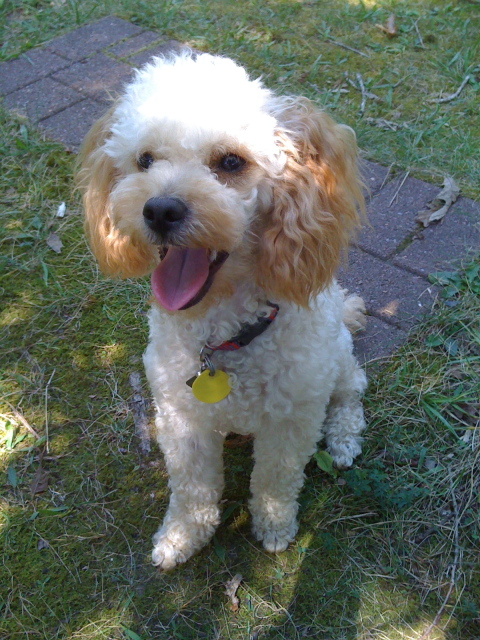 poodle continuing to vomit
Question
Oliver
Last week my 11 month old miniat
poodle continuing to vomit
Question
Oliver
Last week my 11 month old miniat
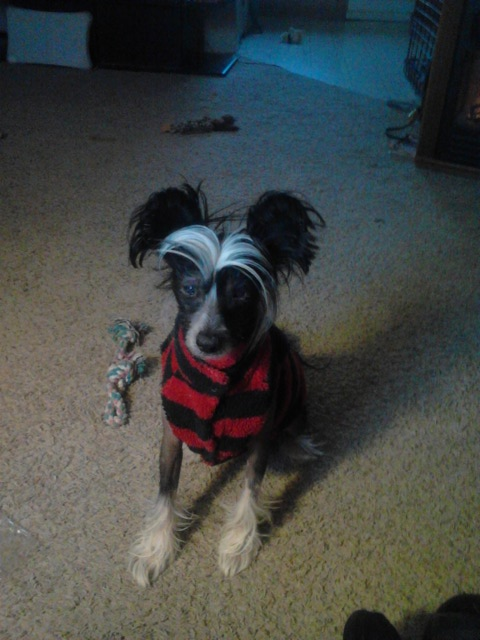 poodle just shaved
QuestionI have an almost one year old standard poodle m
poodle just shaved
QuestionI have an almost one year old standard poodle m
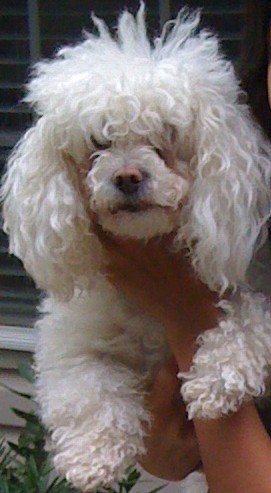 Poodle Depression??
Question
Buubles
Hi, I have a 7 year-old toy poodle. Sh
Poodle Depression??
Question
Buubles
Hi, I have a 7 year-old toy poodle. Sh
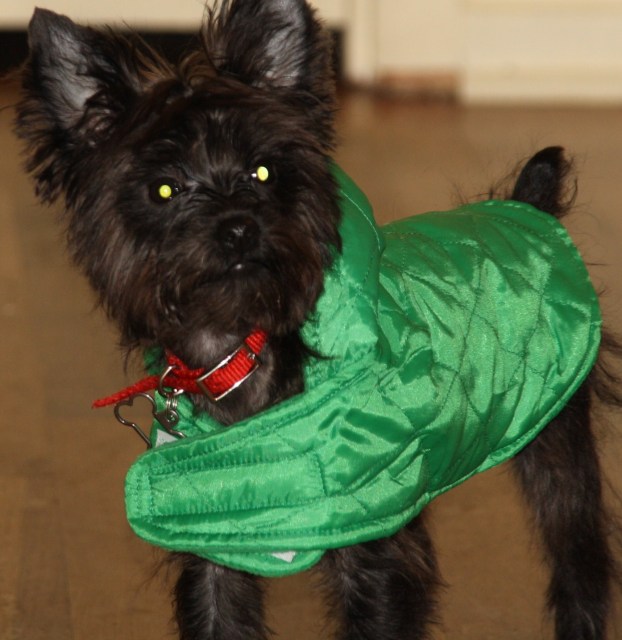 Precious Yorki Poo Coat
Question
PJ
Hello,
I have an 8 month old Yorkie poo. Re
Precious Yorki Poo Coat
Question
PJ
Hello,
I have an 8 month old Yorkie poo. Re
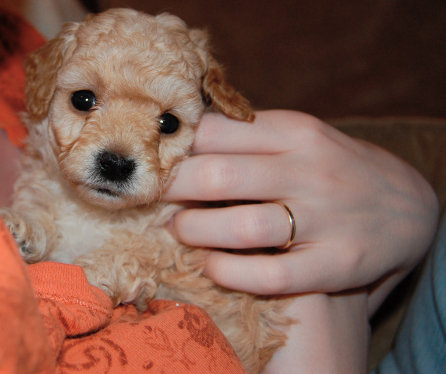 is my tiny poodle pup eating enough?
Question
oscar
We recently brought home our 8 week male
is my tiny poodle pup eating enough?
Question
oscar
We recently brought home our 8 week male